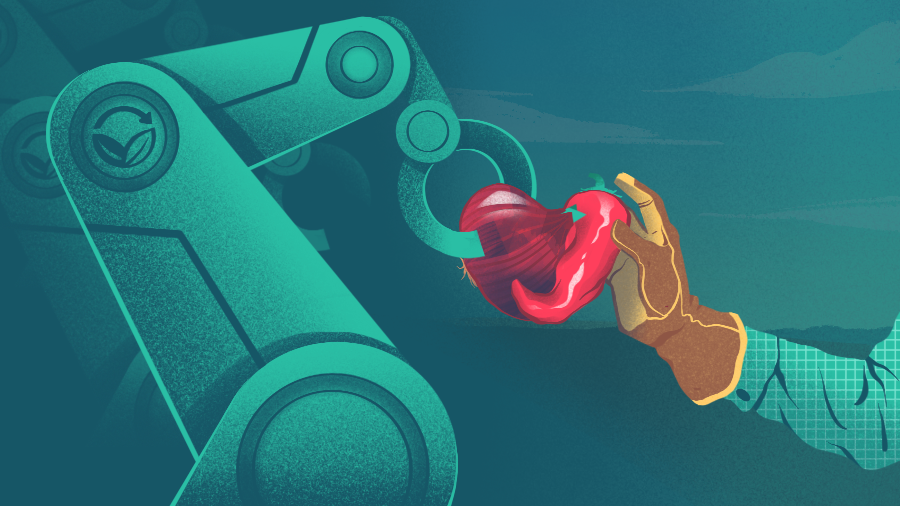Americans love eating out. This year, we’re forecast to spend more than $1.1 trillion doing so — the highest total ever, per the National Restaurant Association.
Trouble is, restaurants need people to provide those drinks, meals and snacks. By the end of the year, the industry will likely employ nearly 16 million of us nationwide. But it won’t be enough: Nearly half of food service employers today say they need more workers.
Theoretically, automation could go a long way to ease the labor shortage. To that end, startups have tried to pitch in over the past few years, bringing us robot waiters, baristas, pizza chefs, burger-flippers and french fry cooks.
Their efforts have produced some high-profile flameouts, like SoftBank-backed robot pizza maker Zume. However, we’re also still seeing maturing startups draw investment for tasks like delivering food to tables and cooking fries.
As labor shortages persist, meanwhile, employers may be warming up to what bots have to offer.
“Restaurants have no choice,” said Richard Hull, CEO of Miso Robotics, a startup known for its Flippy robot fry cook. Employers who might previously have been cool to kitchen automation, he said, now see it as a long-term survival strategy.
Per Hull, the pressing issue is that the post-pandemic labor shortages many expected to be temporary have not gone away. The new reality is it’s hard to attract and retain kitchen workers and “part of the reason is a lot of the jobs are not great jobs.”
Dollars for dining bots
While humans might not be flocking to spend eight hours a day manning a deep fryer, robots don’t mind. Ditto for other tasks like bussing tables, fulfilling drive-through drink orders, and grilling burger patties.
The tough job for startups, however, is going from concept to marketable product. Almost equally challenging is convincing investors to back these efforts.
Hurdles aside, a handful are managing to drum up funding, even as overall startup investment has contracted. To illustrate, using Crunchbase data we put together a list of 16 funded companies in the restaurant automation and robotics space, most of which last raised capital in the past year.
The most recently funded on the list, Redwood City, California-based Bear Robotics, picked up a $60 million Series C last week backed by its new largest shareholder LG Electronics. Bear makes autonomous service robots, with a lineup that includes Servi, a bot that can deliver food and drinks or collect dishes.
It’s a large addressable market. In the U.S. alone, more than 4.5 million people are employed serving food and beverages, with a large portion providing table service. There are more than a million job openings each year.
Burgers are also big business. That’s the motivating factor behind Aniai, maker of a burger-cooking robot, which landed $12 million in a January seed financing. The San Jose, California-based company claims its bot, named Alpha Grill, can prepare up to 200 burgers an hour.
Keeping up with the lunch and dinner rush is also a prime focus area, with startups looking to make it easier to speed up food prep for periods of high demand. In this vein, San Francisco-based Chef Robotics, a developer of robots that help food companies increase production volume, recently secured $14.75 million in a combined debt and equity financing, bringing total funding to over $22 million.
A spotty track record
As startup sectors go, restaurant robotics has no shortage of boosters. Early upstarts in the space, like robot barista Cafe X or hyper-automated restaurant Spyce, or Miso’s Flippy, have attracted voluminous media coverage and commentary.
Initial enthusiasm, however, doesn’t always translate into long-term success. Several robotics-enabled eateries are no longer around, including burger outlet Creator and quinoa bowl restaurant Eatsa (whose technology has been woven into another startup, Brightloom).
The biggest bust was Zume, a Silicon Valley startup with plans for robot-enabled pizza delivery that later pivoted to sustainable packaging. It raised more than $400 million between 2015 and 2019 before closing down last year.
Spyce, a robot-enabled restaurant specializing in healthy bowl meals, also closed its original restaurant following a 2021 acquisition by salad chain Sweetgreen. However, its technology is helping to power a new automated eatery called Infinite Kitchen.
Still at first course
Miso’s Hull believes the lofty expectations and anticipation around robot-enabled restaurants contributed to some early, high-profile stalled efforts. While it’s common for seed-stage startups to flame out, in most other sectors it happens more quietly.
In Hull’s view, we’re still at a very nascent stage in the market for restaurant robotics. While eateries have been employing technology in backend operations for some time — as evidenced by well-established businesses like OpenTable and Toast — they’ve advanced more slowly in the kitchen.
Per Hull’s estimate, robotics startups have only been developing and pitching restaurant food prep automation for about five years. They’ve still got a long way to go.
Bottom line: It’s probably early to call robot-enabled kitchen automation either a flop or a runaway success. In the chronology of startup innovation, we’re probably barely at the soup course. Let’s leave time for the entrée and dessert before we render judgment.
Related Crunchbase Pro list:
Illustration: Dom Guzman

Stay up to date with recent funding rounds, acquisitions, and more with the Crunchbase Daily.



![Computer generating AI data. [Dom Guzman]](https://news.crunchbase.com/wp-content/uploads/AI-generated-470x352.jpg)
![Illustration of agentive AI brain - Global - Quarterly. [Dom Guzman]](https://news.crunchbase.com/wp-content/uploads/Agentive_AI_global-470x352.jpg)

![Illustration of a guy watering plants with a blocked hose - Global [Dom Guzman]](https://news.crunchbase.com/wp-content/uploads/quarterly-global-3-300x168.jpg)
67.1K Followers